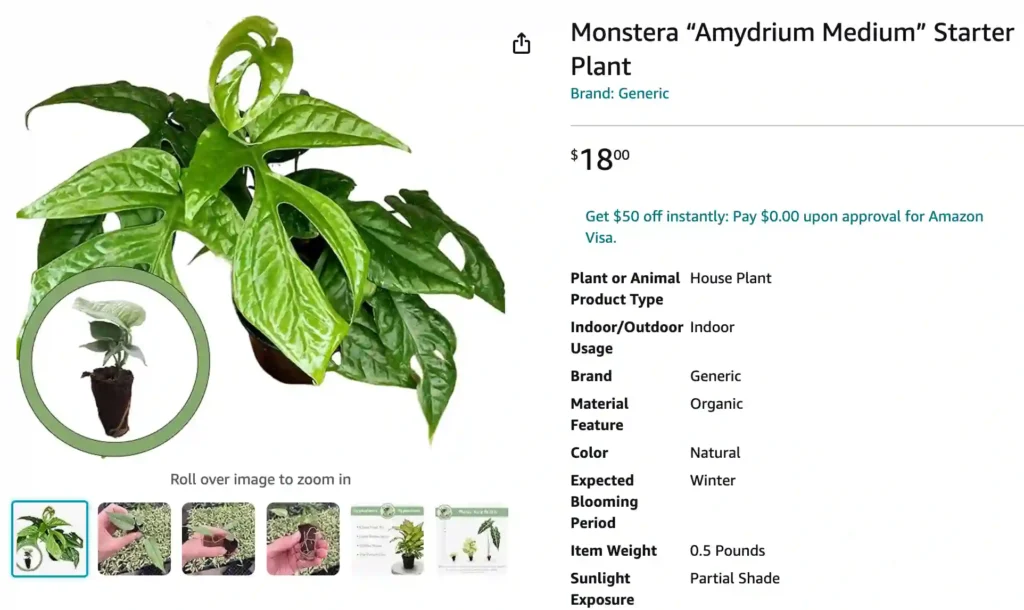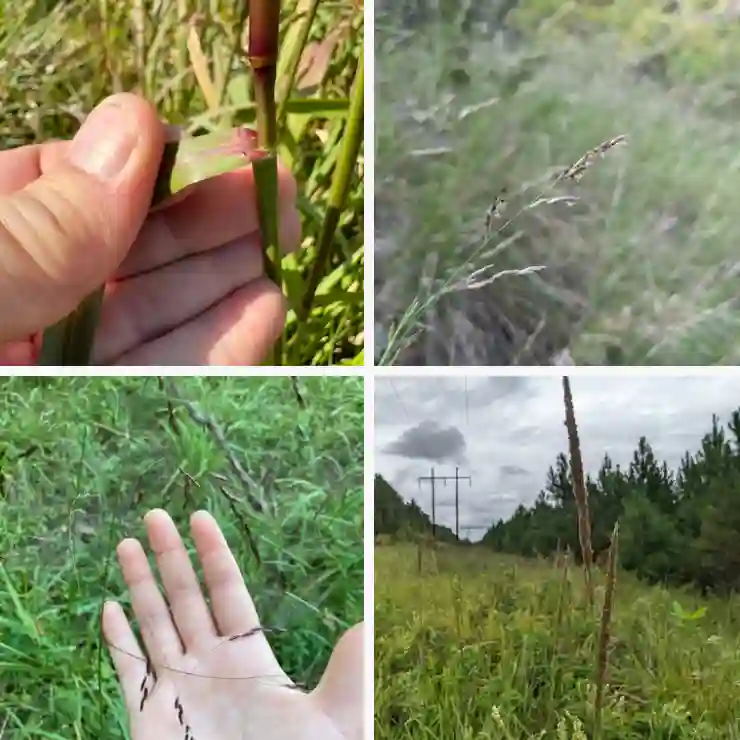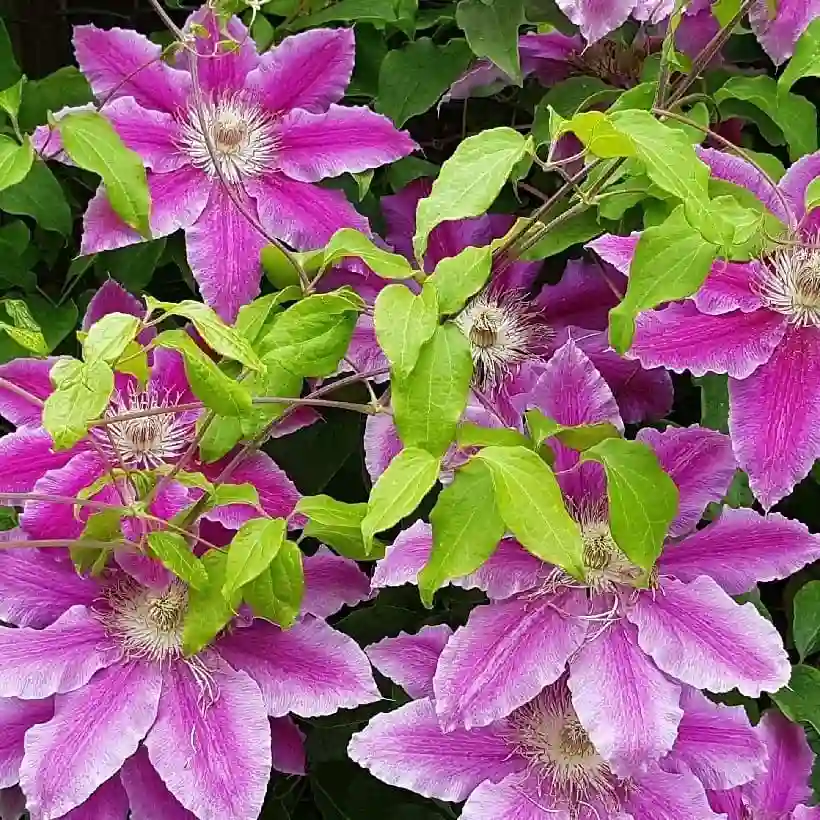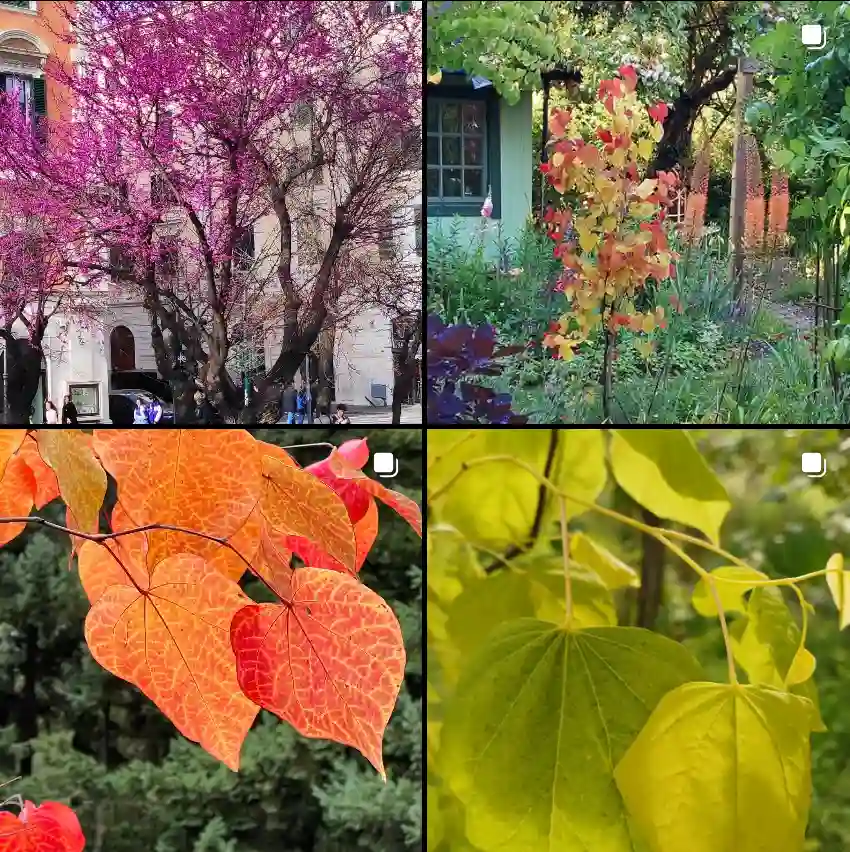
1. Introduction to Amydrium Green: A Versatile Climber
1.1. What is Amydrium Green?
The Amydrium Green, often simply referred to as Amydrium for its non-variegated form, is a fascinating member of the Araceae family. While it shares a close resemblance to Monstera species in its vining and climbing habit, it officially belongs to the Amydrium genus. This plant is celebrated for its rich, vibrant green leaves that can develop intricate textures, prominent veining, and unique fenestrations (splits and holes) as they mature. Its adaptability and striking appearance make it a popular choice for indoor plant enthusiasts seeking an attractive yet relatively resilient climbing aroid.
1.2. Reasons for its Appeal
Amydrium Green appeals to plant lovers for several key reasons:
- Robust and Resilient: Generally more forgiving than variegated Amydrium varieties, making it suitable for a wider range of growers.
- Unique Foliage Development: Its deep green leaves develop characteristically interesting textures and fenestrations as the plant matures and climbs, offering an evolving display.
- Vigorous Growth: With proper care and support, it grows relatively fast, creating a lush, tropical aesthetic.
- Climbing Nature: Ideal for adding vertical interest to indoor spaces when provided with a moss pole or trellis.
2. Origins and Distinguishing Characteristics
2.1. Native Habitat
Amydrium Green is indigenous to the tropical rainforests of Southeast Asia, thriving in countries like Thailand, Malaysia, and Indonesia. In its natural environment, it grows as an understory plant, using its aerial roots to climb up trees and absorb moisture and nutrients from the humid air. This background underscores its preference for warm, humid, and well-lit, but indirect, conditions.
2.2. Leaf Morphology and Texture
Young Amydrium Green leaves typically start as solid, heart-shaped, or elongated ovals. As the plant matures and receives adequate light and vertical support, the leaves become larger and begin to develop more defined features. These can include a prominent, almost leathery texture with sunken veins, and eventually, the formation of unique fenestrations or splits along the leaf margins or within the leaf blade. The vibrant green color is consistent across the foliage.
2.3. Growth Habit and Rate
Amydrium Green is a highly effective climber. It produces abundant aerial roots that readily attach to surfaces, allowing it to ascend rapidly when given a support structure like a moss pole, trellis, or even a wall. Providing this vertical support is crucial not only for promoting its natural growth habit but also for encouraging the development of larger, more mature leaves with enhanced fenestrations. Its growth rate is generally moderate to fast, especially during the warmer growing seasons, adding lush greenery to its environment.
3. Comprehensive Care Guide: Nurturing Your Amydrium Green
Cultivating a thriving Amydrium Green involves replicating the warm, humid, and bright, indirect conditions of its native tropical rainforest habitat.
Table 1: Quick Care Guide for Amydrium Green
| Care Factor | Requirement Description |
|---|---|
| Light | Bright, indirect light. Avoid direct harsh sun. Tolerates slightly lower light than variegated types. |
| Temperature | Ideal range: 18-29°C (65-85°F). Avoid drops below 15°C (59°F). |
| Humidity | High humidity preferred, 60% or higher. |
| Watering | Water when top 1-2 inches of soil are dry. Allow full drainage. Reduce in winter. |
| Soil | Well-draining, airy, rich in organic matter (aroid mix, or potting mix + perlite + orchid bark + coco coir). |
| Fertilization | Balanced liquid fertilizer, diluted, monthly during spring/summer. Withhold in winter. |
| Repotting | Annually or biannually, when root-bound, in spring. Increase pot size slightly. |
3.1. Light Requirements
Amydrium Green thrives in bright, indirect light. This means placing it near a window where it receives plenty of ambient light but is shielded from direct sun exposure, particularly the harsh afternoon sun, which can scorch its leaves. An east or west-facing window is often ideal. While generally more tolerant of varying light conditions than its variegated counterparts, insufficient light will lead to slower growth, smaller leaves, and a lack of the characteristic mature leaf development (texture and fenestrations). Regular rotation helps ensure even growth.
3.2. Temperature and Humidity
Being a tropical plant, Amydrium Green prefers consistently warm temperatures. The ideal range is between 18-29°C (65-85°F). It is crucial to protect the plant from temperatures falling below 15°C (59°F), as cold stress can lead to leaf damage and overall plant decline. Avoid placing it near sudden drafts from open windows, air conditioners, or heating vents.
High humidity is vital for its health and robust growth, ideally ranging from 60% or higher. In typical indoor environments, where humidity can be lower, consider using a room humidifier. Grouping the plant with other moisture-loving plants or placing its pot on a pebble tray filled with water (ensuring the pot does not sit in the water) can also help create a more humid microclimate. Consistent high humidity promotes lush foliage and prevents crispy leaf edges.
3.3. Watering Practices
Proper watering is critical for the Amydrium Green. It prefers its soil to dry out partially between waterings to prevent root rot. A good rule of thumb is to water thoroughly when the top 1-2 inches (2.5-5 cm) of soil feel dry to the touch. Ensure that the pot has excellent drainage holes and that any excess water drains out completely from the bottom. Never let the plant sit in standing water. During the active growing season (spring and summer), it will likely need more frequent watering than during the cooler, dormant months of fall and winter. Using filtered water or rainwater can help prevent mineral buildup in the soil.
3.4. Optimal Soil Mix and Repotting
A well-draining, airy, and nutrient-rich potting mix is essential for the Amydrium Green. This mimics the loose, organic matter it would find in its native climbing environment. An ideal mix should promote good aeration while retaining some moisture. A suitable blend can include:
- High-quality indoor potting mix (approximately 40%)
- Orchid bark (approximately 30%) for excellent aeration and chunkiness
- Perlite or pumice (approximately 20%) to improve drainage and prevent compaction
- Coco coir or worm castings (approximately 10%) for moisture retention and added nutrients
Repotting: Repot your Amydrium Green typically once a year or every two years, or when you notice it has become root-bound (roots growing out of drainage holes, water running straight through the pot). Spring is the best time to repot, as the plant is entering its active growth phase. Choose a new pot that is only 1-2 inches larger in diameter than the previous one, ensuring it has ample drainage.
3.5. Fertilization Strategies
During its active growing season (spring and summer), fertilize your Amydrium Green monthly with a balanced liquid fertilizer, diluted to half the recommended strength. This provides the necessary nutrients to support vigorous growth and maintain its lush foliage. Reduce or completely stop fertilizing during the fall and winter months when the plant’s growth naturally slows. Over-fertilization can lead to salt buildup in the soil, which can burn the roots and cause leaf damage. Always water the plant thoroughly before applying fertilizer to protect the roots.
4. Propagation Techniques: Expanding Your Collection
Propagating Amydrium Green is a straightforward and rewarding way to create new plants. The most common and effective method is using stem cuttings.
4.1. Stem Cuttings
- Select a Healthy Stem: Choose a healthy, mature stem section that has at least one node (the point where a leaf or aerial root emerges) and preferably one or two healthy leaves. Cuttings with an existing aerial root often root faster.
- Sterilize Tools: Always use clean, sharp, and sterilized pruning shears or a knife to make your cuts. This prevents the spread of diseases.
- Make the Cut: Cut just below a node. Remove any lower leaves that would be submerged in your chosen rooting medium to prevent rot.
- Rooting Medium Options:
- Water Propagation: Place the cutting in a clear jar with fresh water, ensuring the node is submerged. Change the water every few days to keep it clean. Roots typically begin to form within a few weeks.
- Sphagnum Moss: Plant the cutting in moist, but not soggy, sphagnum moss. This medium is excellent for encouraging root growth due to its aeration and moisture retention properties.
- Soil: You can also plant the cutting directly into a small pot filled with a well-draining, airy potting mix. Keep the soil consistently moist.
- Provide Optimal Environment: Place your cuttings in a warm location that receives bright, indirect light. High humidity (e.g., within a propagation box or covered with a clear plastic bag) will significantly accelerate the rooting process.
- Potting Up: Once the roots are a few inches long (for water or moss propagation) or significant new leaf growth is visible (for soil propagation), your new plant is ready to be transitioned to a larger pot with its permanent potting mix.
5. Troubleshooting Common Issues: Pests, Diseases, and Environmental Stress
While generally resilient, Amydrium Green can encounter issues if its environmental needs are not met. Prompt identification and action are crucial for maintaining its health.
Table 2: Common Problems & Troubleshooting for Amydrium Green
| Problem | Symptoms | Solutions/Treatment |
|---|---|---|
| Yellowing Leaves | Older, lower leaves turning yellow. | Overwatering (most common), nutrient deficiency, natural aging. Adjust watering, fertilize, check roots for rot. |
| Brown Crispy Edges/Tips | Leaves browning and feeling crispy at edges. | Low humidity, underwatering, direct sun exposure. Increase humidity, adjust watering, move to indirect light. |
| Drooping Leaves | Leaves looking limp and losing turgor. | Underwatering (most common), severe overwatering (root rot), cold shock. Check soil moisture, inspect roots, ensure warmth. |
| No Fenestrations/Textured Leaves | New leaves remain solid, lack texture. | Insufficient light, immature plant, lack of climbing support. Provide brighter indirect light, offer a moss pole, be patient. |
| Pest Infestations | Visible pests (mealybugs, spider mites, thrips, scale), sticky residue, distorted growth. | Isolate plant, treat with insecticidal soap, neem oil, or appropriate pesticides. Increase humidity. |
| Root Rot | Mushy stem base, black/brown, foul-smelling roots, yellowing/wilting. | Overwatering, poor drainage. Repot, trim rotten roots, improve drainage, reduce watering. |
| Leggy Growth | Long stems with sparse leaves. | Insufficient light. Move to a brighter location. Prune to encourage bushier growth. |
5.1. Watering Issues
- Overwatering: The most common cause of problems. Symptoms include yellowing leaves (particularly older, lower ones), black/brown spots on leaves, a mushy stem near the soil line, and a foul, moldy smell from the soil. This eventually leads to root rot.
- Solution: Allow the top 1-2 inches of soil to dry out completely between waterings. Ensure the pot has excellent drainage. If root rot is suspected, unpot the plant, trim any rotted, mushy roots, and repot in fresh, well-draining soil.
- Underwatering: Symptoms include drooping or wilting leaves, crispy brown edges or tips, and overall dull foliage.
- Solution: Increase watering frequency. Ensure you are watering thoroughly so that water drains from the bottom of the pot, indicating the entire root ball has been moistened.
5.2. Light Issues
- Insufficient Light: Can lead to slower growth, smaller leaves, leggy stems, and a lack of the characteristic mature leaf development (texture and fenestrations).
- Solution: Move the plant to a location that receives brighter, indirect light. Consider supplementing with a grow light if natural light levels are consistently low.
- Too Much Direct Light: Especially harsh afternoon sun, can cause leaf scorch, resulting in brown, crispy patches or faded areas on the leaves.
- Solution: Relocate the plant to a spot with filtered light, or use sheer curtains to diffuse intense sunlight.
5.3. Humidity and Temperature Stress
- Low Humidity: Often causes the leaf edges or tips to turn brown and crispy. New leaves might struggle to unfurl properly.
- Solution: Increase ambient humidity using a humidifier, pebble tray, or by grouping plants together.
- Cold Stress: Exposure to temperatures below 15°C (59°F) can severely stress the plant, leading to leaf damage, wilting, and overall decline.
- Solution: Ensure the plant is in a consistently warm environment and protected from cold drafts from windows or air vents.
5.4. Pests
While generally resilient, Amydrium Green can occasionally attract common houseplant pests like mealybugs, spider mites, thrips, and scale.
- Symptoms: Visible insects (white, cottony masses for mealybugs; tiny moving dots and fine webbing for spider mites), sticky residue (honeydew), or speckled, distorted leaves.
- Solution: Regularly inspect your plant, especially the undersides of leaves and stem crevices. Isolate infested plants immediately. Treat with appropriate organic pest control methods such as insecticidal soap, neem oil, or by wiping pests off with an alcohol-dipped cotton swab. Increasing humidity can help deter spider mites.
5.5. Root Rot
This is a serious fungal disease, almost always a result of overwatering and poorly draining soil.
- Symptoms: Yellowing, wilting leaves (even when the soil is wet), a mushy stem near the soil line, and black/brown, foul-smelling roots.
- Solution: Immediately remove the plant from its pot. Carefully inspect the roots and prune away all affected (mushy, black) sections with sterilized shears. Repot the plant in fresh, well-draining aroid mix, and adjust your watering schedule to allow the soil to dry adequately between waterings.
6. Conclusion: Enjoying Your Thriving Amydrium Green
The Amydrium Green, with its lush green foliage and captivating textural development, is a truly rewarding plant for any indoor gardener. By consistently providing it with bright, indirect light, appropriate watering, high humidity, stable warm temperatures, and a well-draining soil mix with adequate climbing support, you can ensure this unique aroid thrives. Its resilience and striking appearance make it an excellent choice for adding a touch of the tropics and fascinating botanical interest to your indoor space.
If i die, water my plants!



